Manes (profeta)
Manes ou Mani (em persa médio e siríaco: Mānī; em grego koiné: Μάνης; em latim: Manes), também conhecido como Maniqueu (em grego: Μανιχαίος; em latim: Manichaeus; em siríaco: ܡܐܢܝ ܚܝܐ, Mānī ḥayyā, "Mani Vivo"; c. 216–276), foi um profeta de origem iraniana,[1][2][3][4] fundador do maniqueísmo, uma religião gnóstica extinta atualmente, mas que foi bastante difundida durante a Antiguidade tardia. Manes nasceu em Ctesifonte (ou em suas proximidades), na satrapia do Assuristão (Assíria), à época parte do Império Parta. Seis de suas principais obras foram escritas no aramaico siríaco, e a sétima, dedicada ao monarca do império, Sapor I (r. 242–273), foi escrita no persa médio.[5] Morreu em Bendosabora, já sob o Império Sassânida.
| Manes | |
|---|---|
| Nascimento | 14 de abril de 216 Ctesifonte (Império Parta) |
| Morte | 2 de março de 274 Bendosabora (Império Sassânida) |
| Cidadania | Império Parta, Império Sassânida |
| Ocupação | teólogo, escritor, profeta, líder religioso, filósofo, poeta |
| Religião | maniqueísmo |
| Causa da morte | esfolamento |
Vida
editarPouco se sabe, com certeza, a respeito da vida de Manes. Sabe-se que ele nasceu no que hoje é o Iraque (naquele tempo território do Império Sassânida) durante o século III. A data tanto de seu nascimento quanto de sua morte é incerta e varia de acordo com os autores.[6] Teve, quando jovem ainda, uma visão em que seu anjo protetor o ordenava isolar-se do mundo para receber a revelação de uma nova religião, que seria a interpretação correta de diversas crenças religiosas da época. Depois de receber essa revelação, passou a pregar, na Pérsia, um novo entendimento do zoroastrismo, o qual tentou conciliar com os fundamentos do cristianismo. Dotado de grande aptidão para aprender línguas, viajou pela Índia, China e Tibete, de onde recolheu ensinamentos religiosos e filosóficos que acrescentou a sua religião. Após gozar da proteção do rei Sapor I, sofreu perseguição dos sacerdotes do zoroastrismo, os Magos, durante o reinado de Vararanes I (r. 274–277). Preso e condenado como herege, teria sido, segundo a tradição, esfolado vivo e sua carne atirada ao fogo, enquanto que sua pele, crucificada em praça pública na cidade de Bendosabora.
A sua vida é descrita no Vita Mani escrito em grego, mas de origem aramaica.
Ver também
editarReferências
- ↑ Boyce, Mary (2001). Zoroastrians: their religious beliefs and practices. [S.l.]: Routledge. p. 111.
He was Iranian, of noble Parthian blood...
- ↑ Ball, Warwick (2001). Rome in the East: the transformation of an empire. [S.l.]: Routledge. p. 437.
Manichaeism was a syncretic religion, proclaimed by the Iranian Prophet Mani
. - ↑ Sundermann, Werner (2009). «Mani, the founder of the religion of Manicheism in the 3rd century CE». Iranica. [S.l.]: Sundermann.
According to the Fehrest, Mani was of Arsacid stock on both his father’s and his mother’s sides, at least if the readings al-ḥaskāniya (Mani’s father) and al-asʿāniya (Mani’s mother) are corrected to al-aškāniya and al-ašḡāniya (ed. Flügel, 1862, p. 49, ll. 2 and 3) respectively. The forefathers of Mani’s father are said to have been from Hamadan and so perhaps of Iranian origin (ed. Flügel, 1862, p. 49, 5–6). The Chinese Compendium, which makes the father a local king, maintains that his mother was from the house Jinsajian, explained by Henning as the Armenian Arsacid family of Kamsarakan (Henning, 1943, p. 52, n. 4 = 1977, II, p. 115). Is that fact, or fiction, or both? The historicity of this tradition is assumed by most, but the possibility that Mani’s noble Arsacid background is legendary cannot be ruled out (cf. Scheftelowitz, 1933, pp. 403–4). In any case, it is characteristic that Mani took pride in his origin from time-honored Babel, but never claimed affiliation to the Iranian upper class.
- ↑ Bausani, Alessandro (2000). Religion in Iran: from Zoroaster to Baha'ullah. [S.l.]: Bibliotheca Persica Press. p. 80.
We are now certain that Mani was of Iranian stock on both his father's and his mother's side
. - ↑ Henning, W.B., The Book of Giants, BSOAS, Vol. XI, Part 1, 1943, pp. 52–74: "…Mani, who was brought up and spent most of his life in a province of the Persian empire, and whose mother belonged to a famous Parthian family, did not make any use of the Iranian mythological tradition. There can no longer be any doubt that the Iranian names of Sām, Narīmān, etc., that appear in the Persian and Sogdian versions of the Book of the Giants, did not figure in the original edition, written by Mani in the Syriac language."
- ↑ A acrescentar.
Bibliografia
editar- Jardins de Luz (2003), (fr: Les jardins de lumière, 1991; en: Gardens of light, 1997), de Amin Maalouf, Mediasat ISBN 84-9789-005-1
